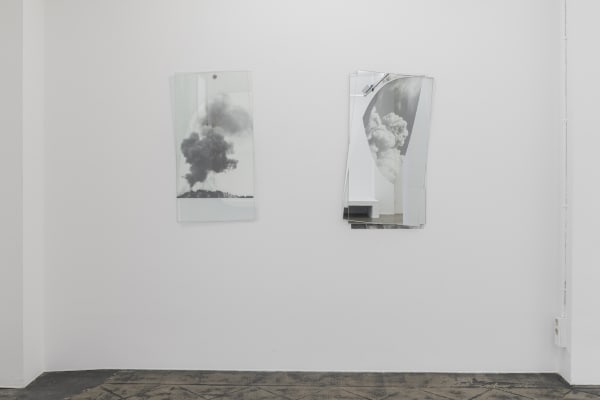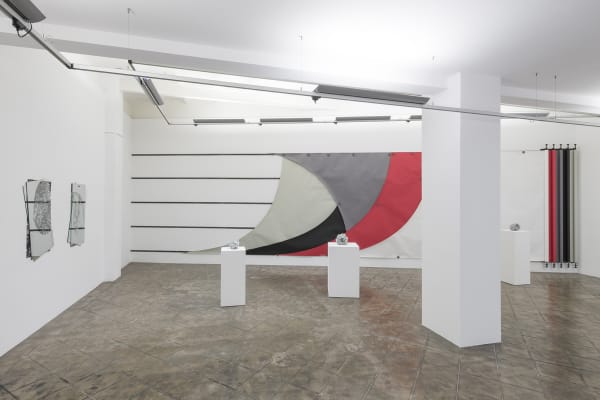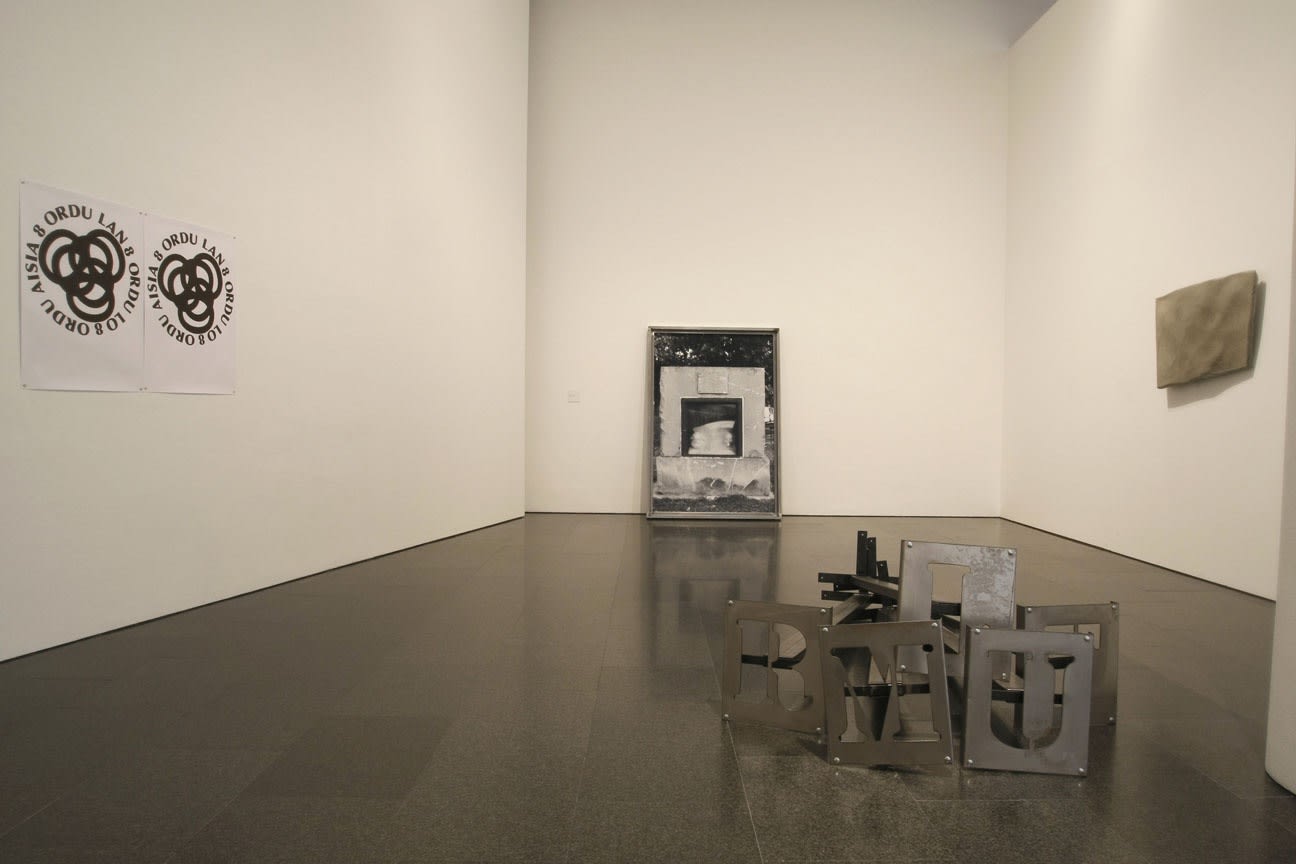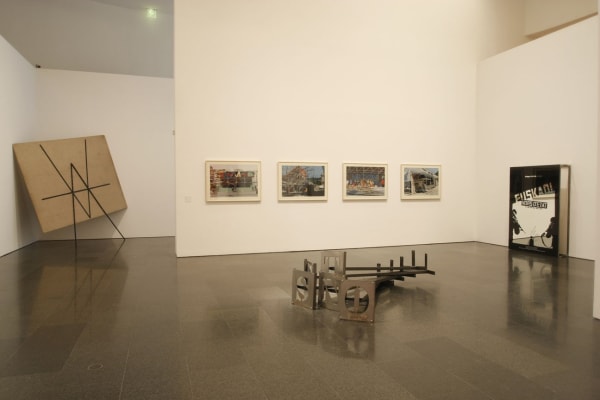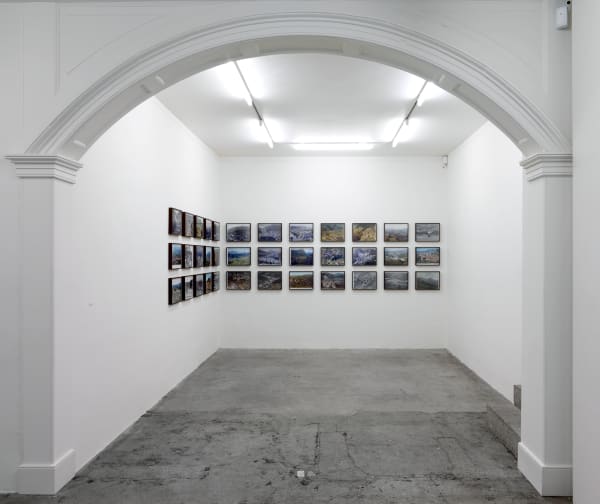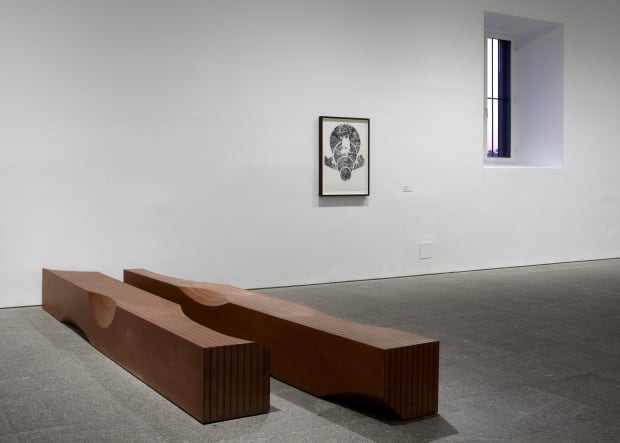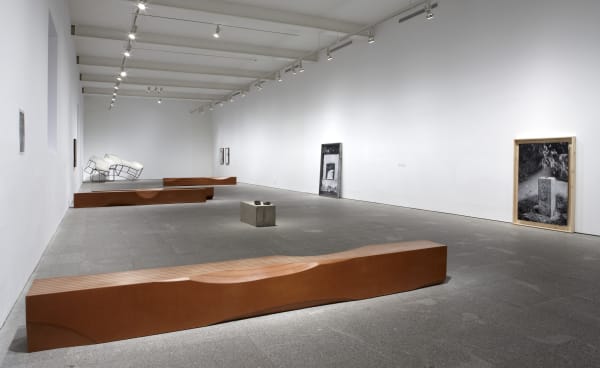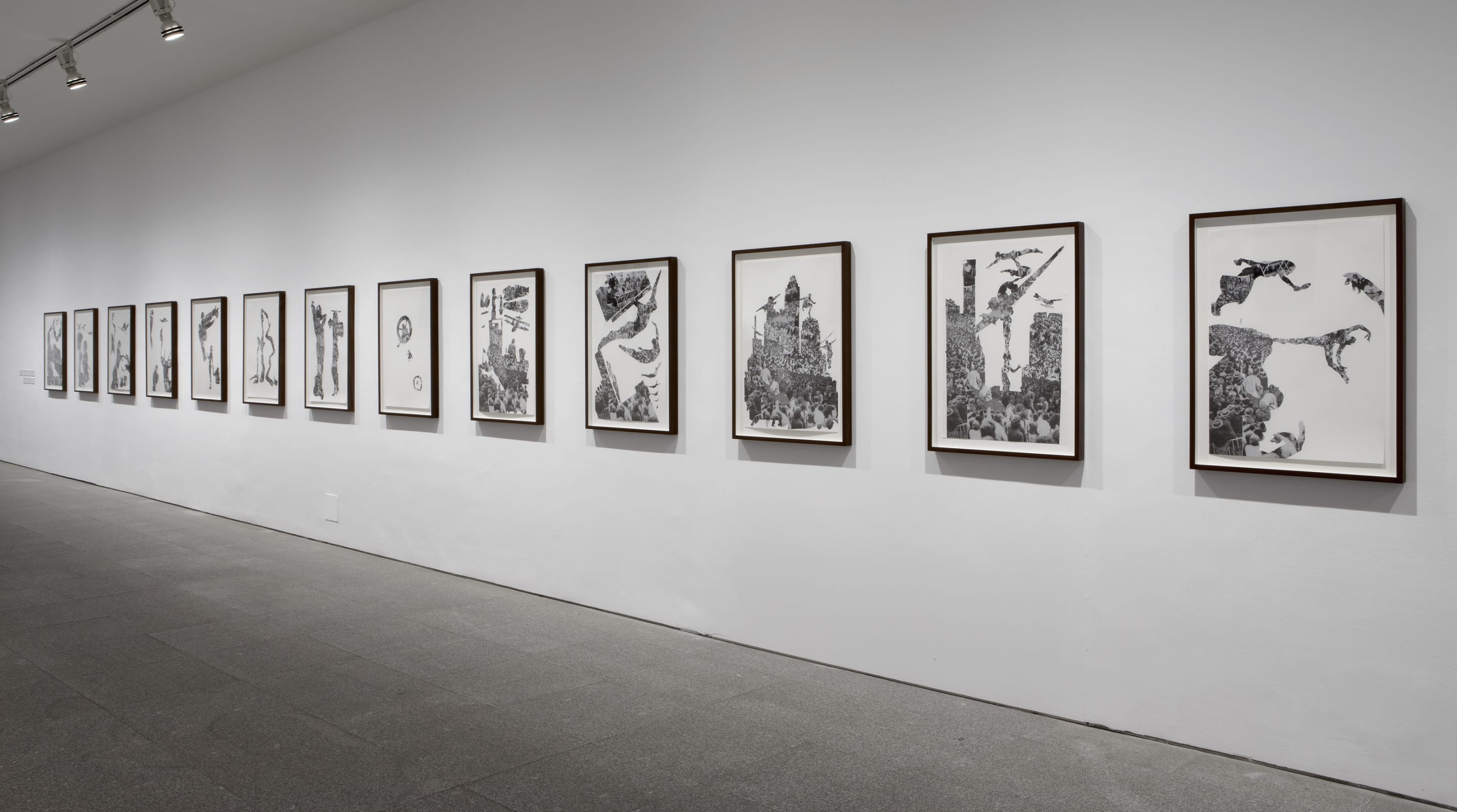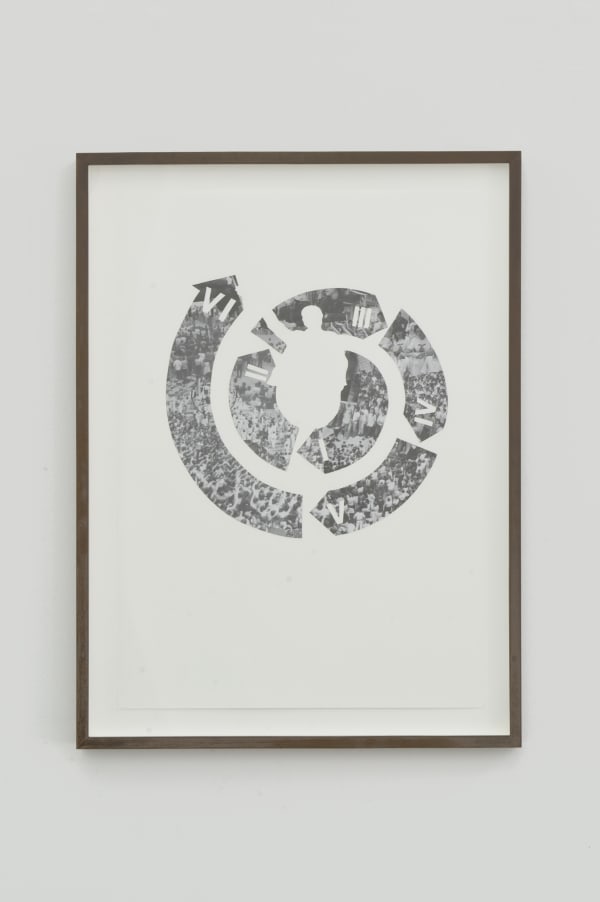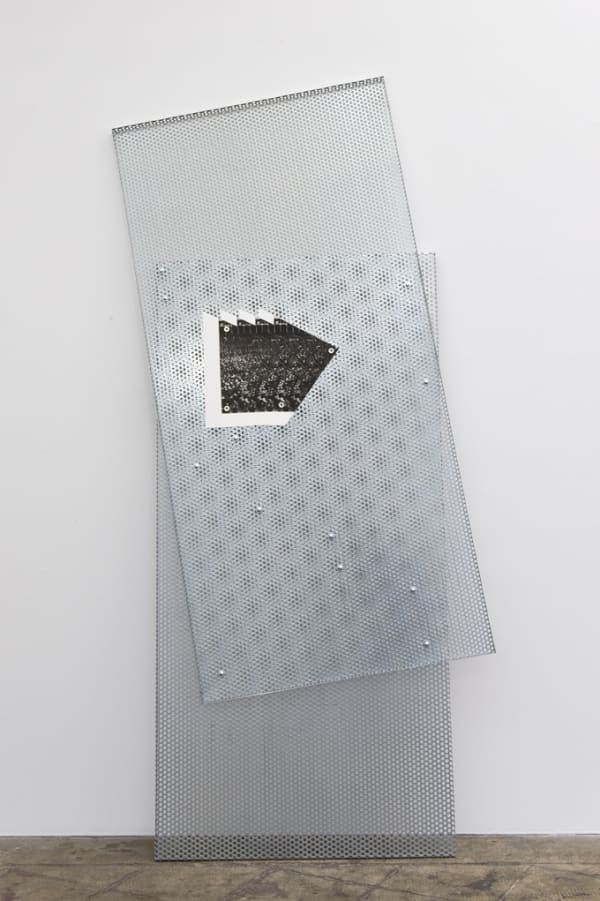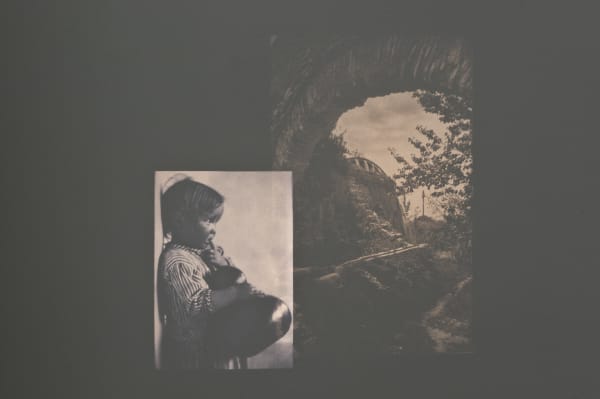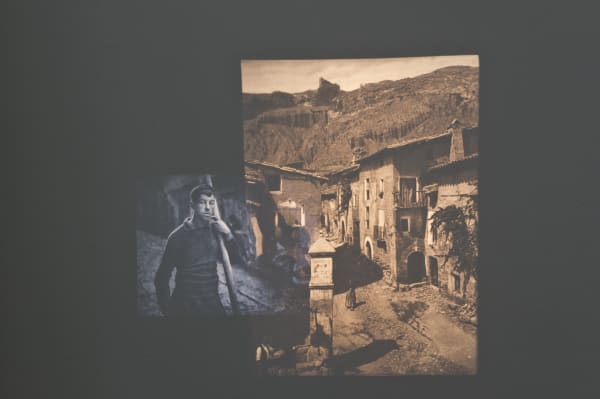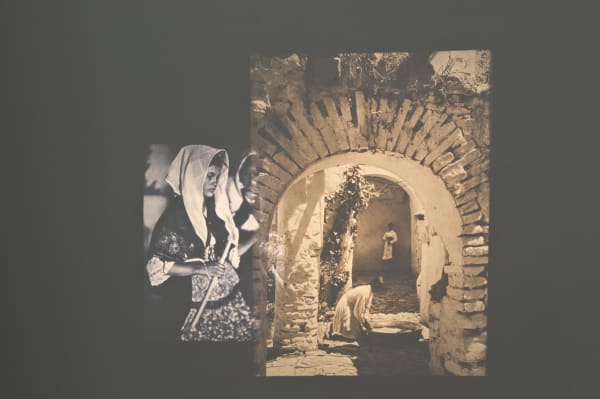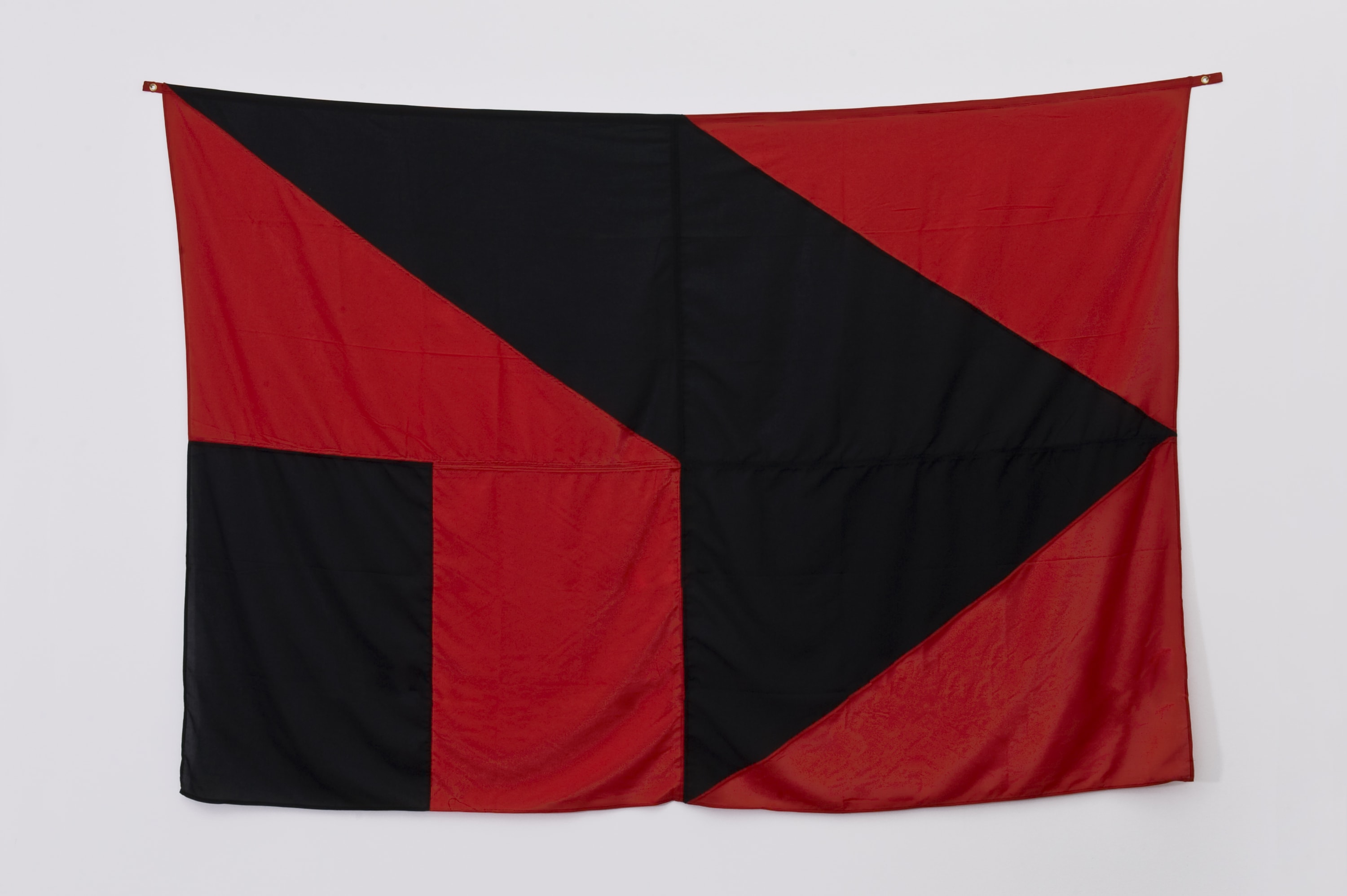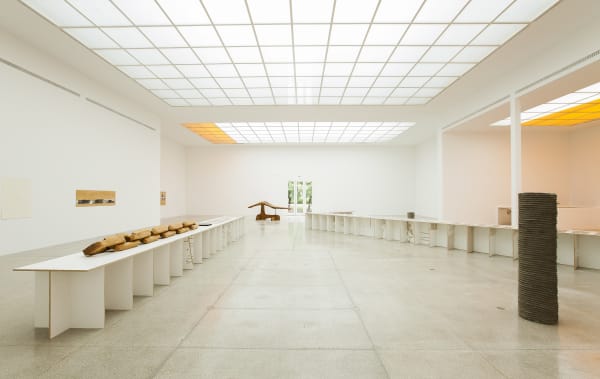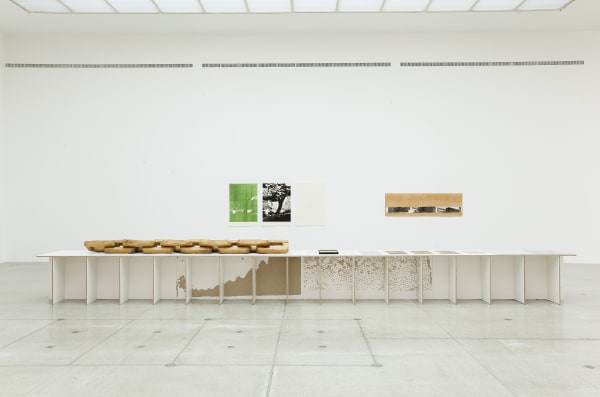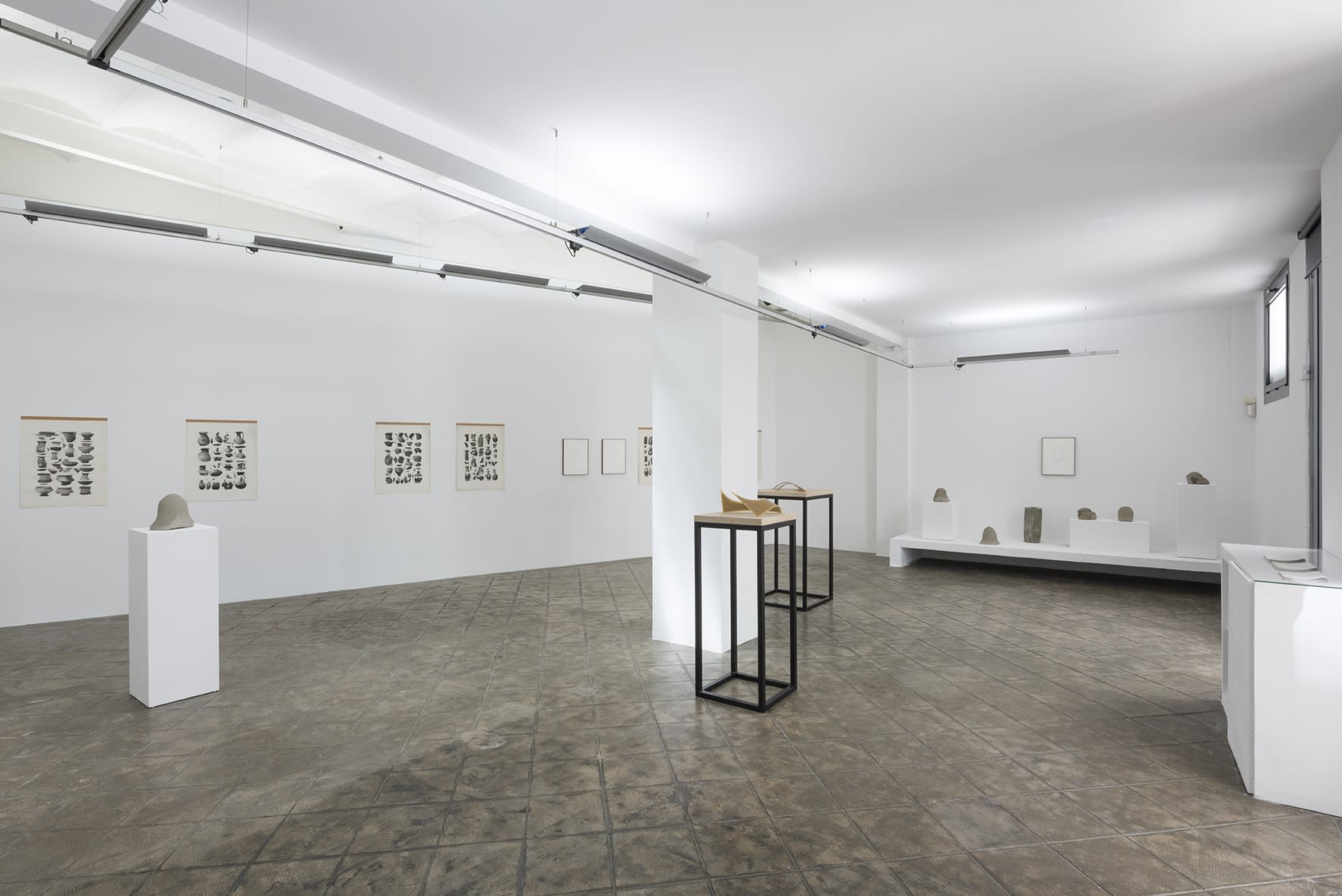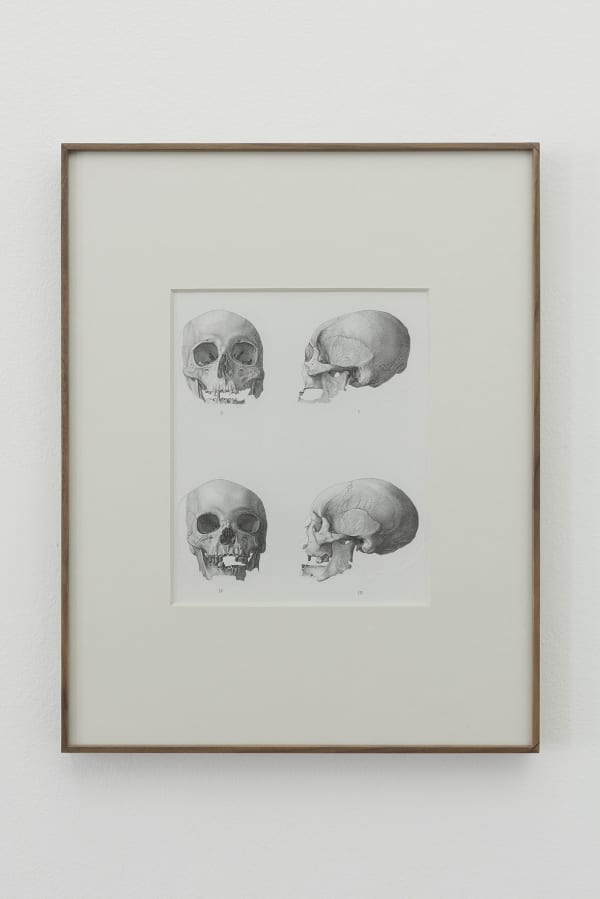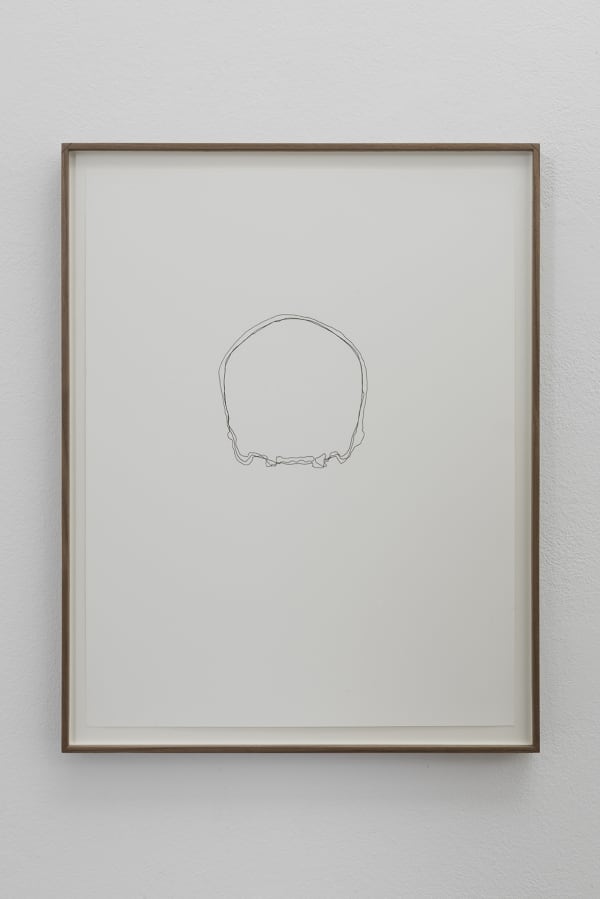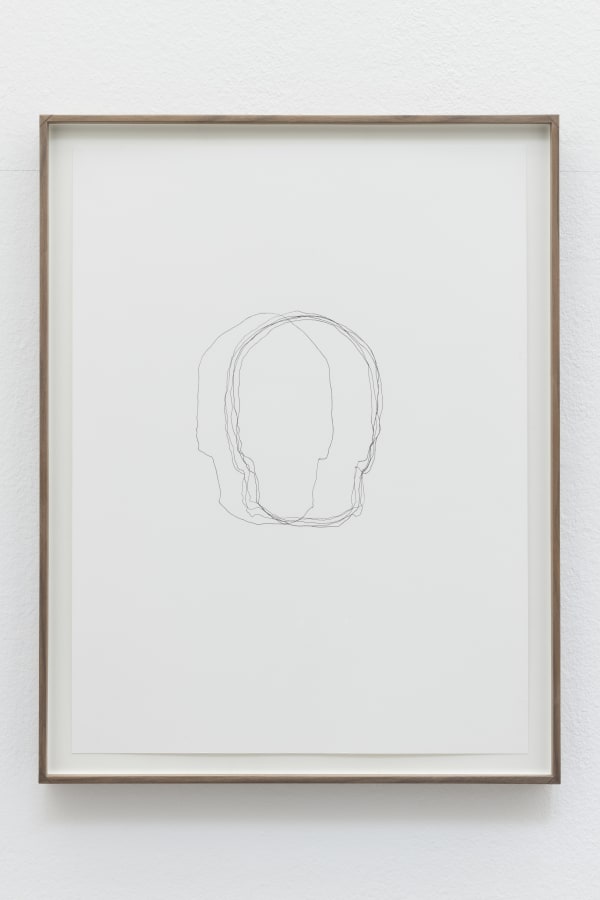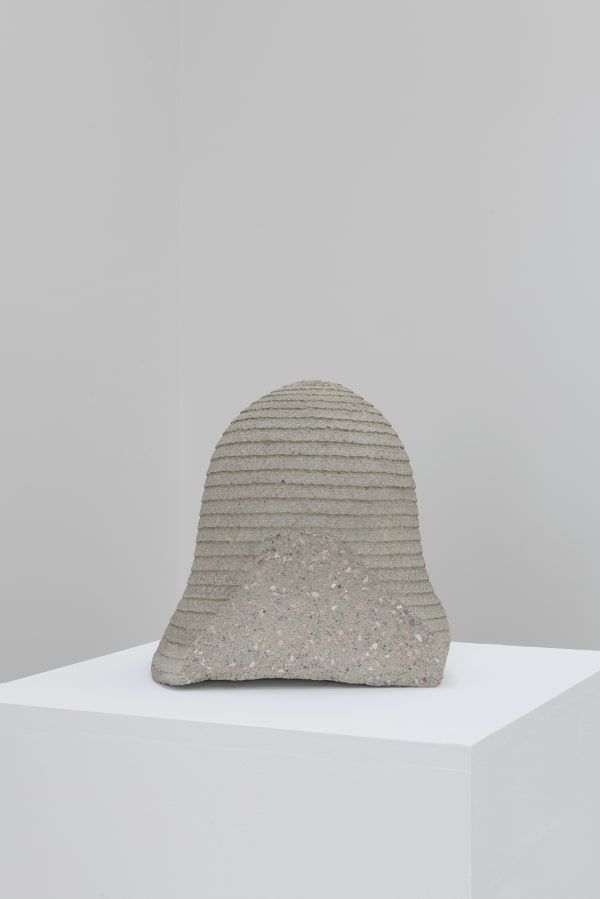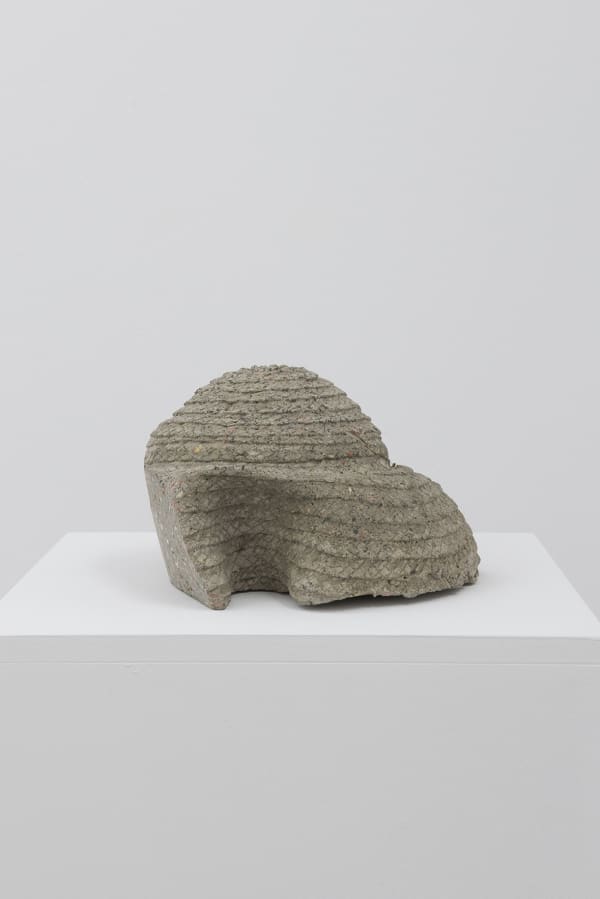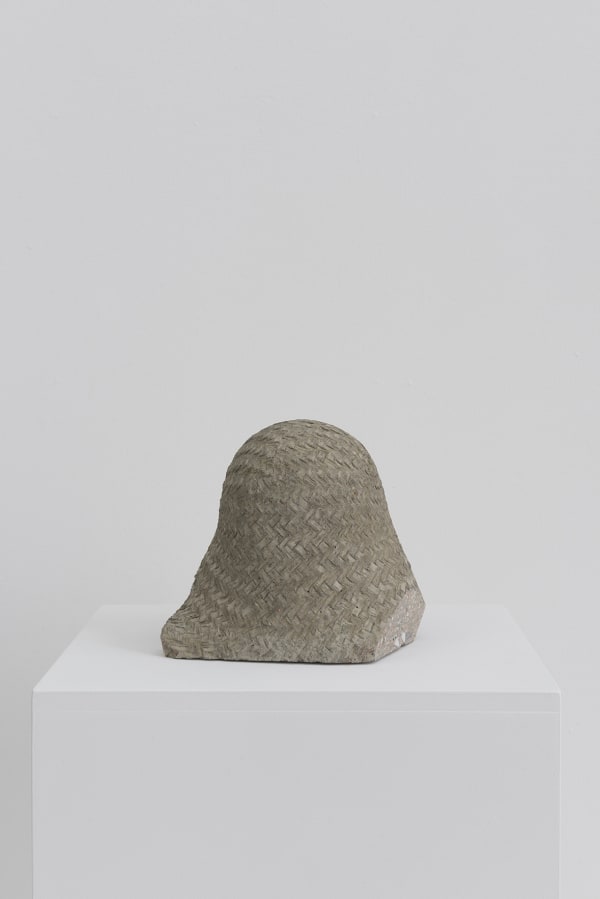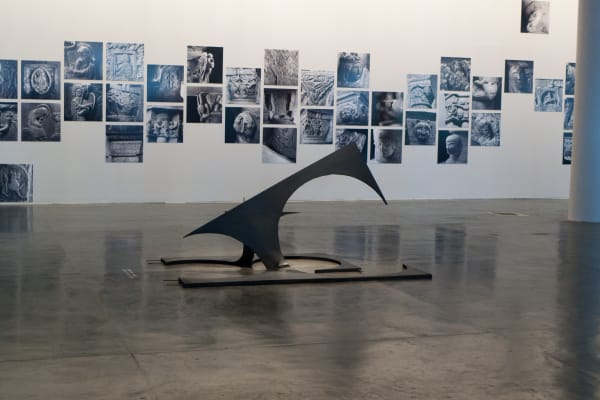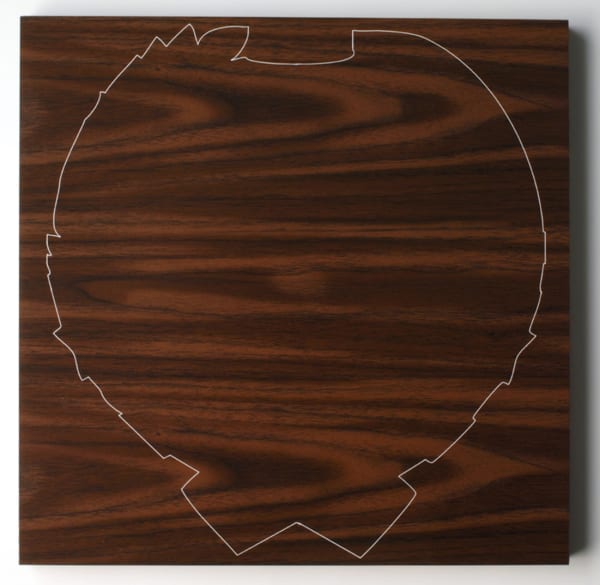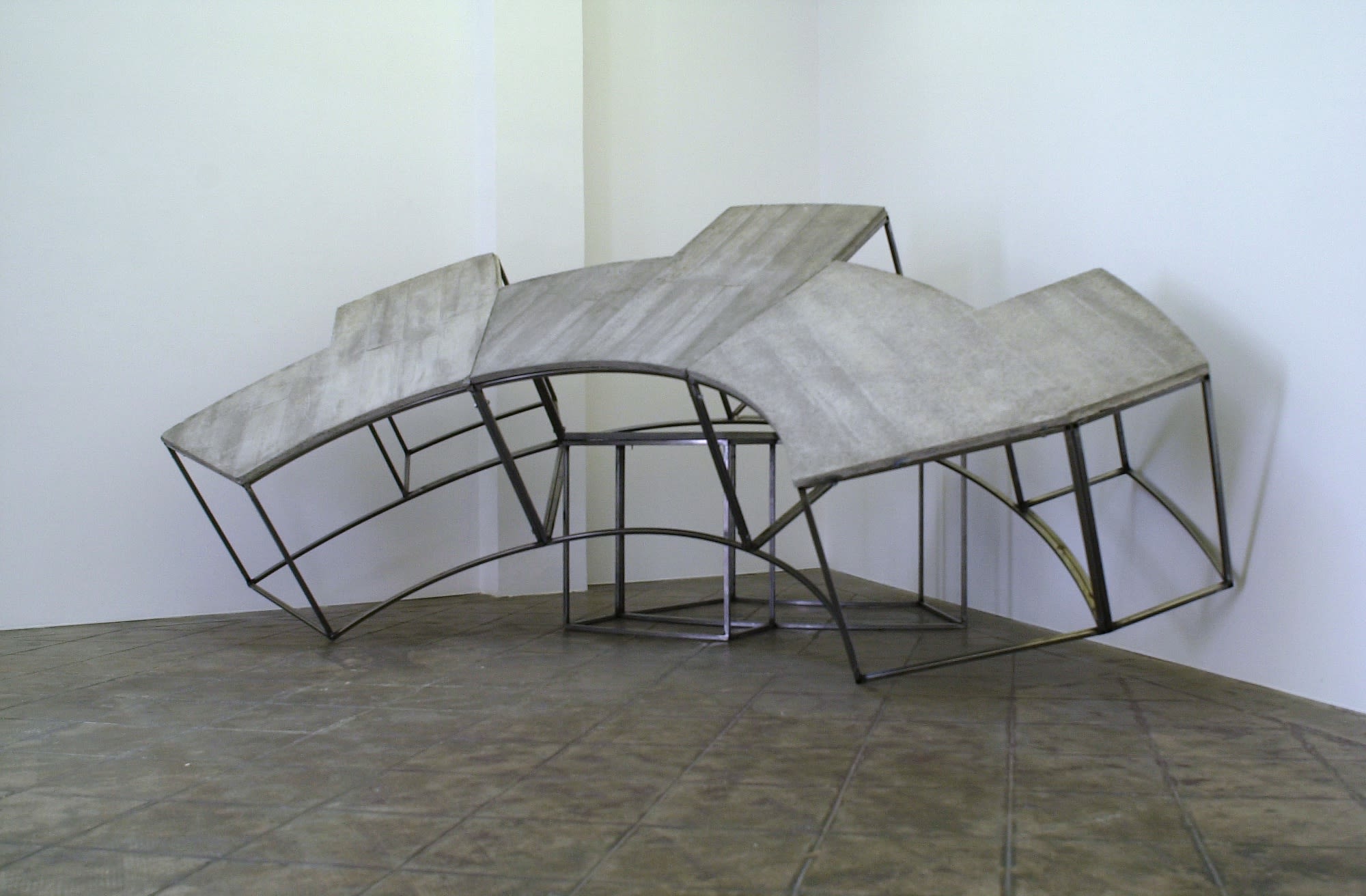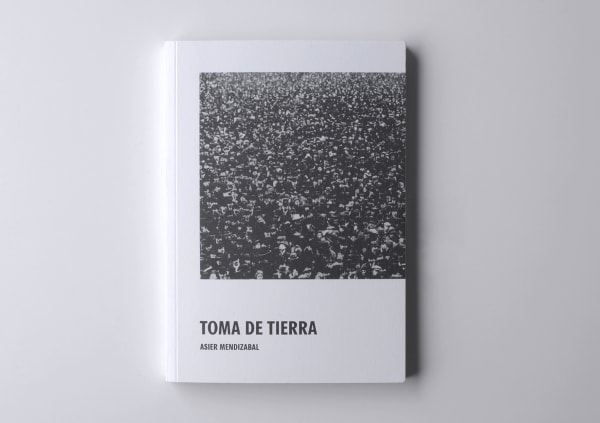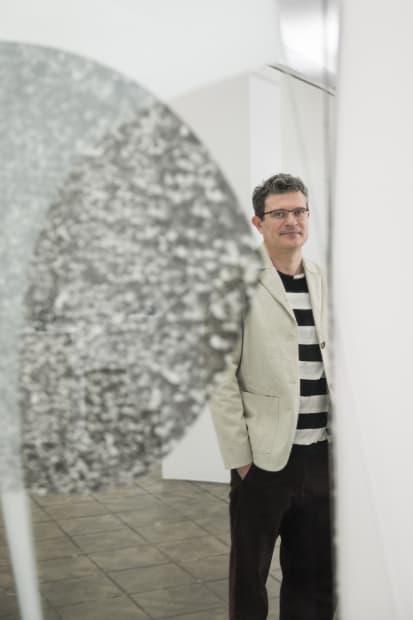-
-
Recognized as one of the most prominent artists on the current Spanish contemporary scene, Asier Mendizabal has developed a remarkable body of work that has focused mainly on the relationships between form, discourse and ideology. The question of the sign and its materiality and identification as a social and political emblem has a place among the artist’s interests. Although abstract sculpture is his most representative medium, his work is resolved through various means and procedures. Collages, installations, flags or banners, photographs and works on paper are an important part of his artistic vocabulary, always with an intuitive sense for the graphic and the sculptural. The artist is the author of many texts that are closely linked to his artistic practice.
We begin this synthetic view of Mendizabal's parcours with his current exhibition at ProjecteSD. Sinfines brings together a group of new works in which the ambiguous relationship between fragment and totality, background and figure, sign and meaning, recurring subjects in Mendizabal’s oeuvre, are revisited from a new point of view. Sinfines is the plural of the Spanish word Sinfín which is a colloquial term for the backdrops used in studio photography, but it also means endless and in its plural version, “endlesses”.
-
SINFINES (ProjecteSD, barcelona , 2021)
-

Asier Mendizabal
Sinfines, 2021Paper backdrops, magnets, iron plates and accessories.
299 x 1172 cm. (Work adaptable to ther mesaures and spaces).
Unique -
Sinfines takes the title from the piece that centers the exhibition, a large mural that runs along the entire width of the main wall in the gallery. Mendizabal has worked with several rolls of backdrops of various colors, which are used as neutral backgrounds for studio photography. Cut out and superimposed on several layers, having altered the axis of what would be its regular use, compositions are generated that could evoke geometric abstractions. What Mendizabal highlights with this exercise is the interchangeability of each composition. Each hyperbola, each curve drawn or cut is not permanent, it seems to be able to be displaced, replaced, if we change the order and move the rolls of each backdrop.
-
A similar modus operandi is used in the Parabel series of collages. Through sections by cuts and superimpositions of two photographic papers that interrupt the continuity of the image of an already obsolete delineation tool, the formal pattern is broken to make parabolic compositions of a random character appear. New forms without continuity, interrupted and meaningless.
-
Overlays are the basis for the sculptures in the Diagramas de dispersión (scatterplot) series. In these, highly enlarged and printed cutouts of various images (crowds, clouds of smoke ...) are combined with glass and mirrors on top of each other, so that the subject of each composition becomes difficult to visualize. Not only due to the assembly of the layers but also, even more, due to the interference of what is reflected on the specular areas in them. For the title, Mendizabal has referred to terms or tools used in mathematics. In the same way that it is usually interpreted in these statistical graphs, in Mendizabal's sculptures, it is also the mixture of simple relationships between variables that becomes visually evident as overlapping patterns.
-
In contrast to this "dispersion" we find the small sculptures in the Condensar (condense) series. Made with industrial metal chains and plastic zip ties, these are dense, nuclear works, motley masses, closed, tied, that go against the supposed mobility of a chain, the linearity of a graphic or linguistic sequence. If in the previous a reference was made to the Cartesian of the mathematical graphics, here this scheme is broken to return us to a more chaotic and more organic space.
-

-
ASIER MENDIZABAL (MACBA, BARCELONA, 2008)
All photos: Juanchi Pegoraro, MACBA -

-
"Mendizabal constructs works that create moments of great symbolic power under the aegis of signs known to the group and images of an apparent realism. Yet this realism is never literal. Seeking in the fault lines of a (functional and economic) modernity that, coming late to the region itself, is already dispossessed of the desire to set itself up as a universal language, to the artist the terrain remains of the vernacular as a space of investigation and source of meanings. Modernity gets to Spanish territory already transformed into modernism: the industrialisation of the Basque Country in the fifties, the alteration of a semi-rural social and a demographic composition through the phenomenon of immigration, and the evolution of a polarised political situation since the sixties, one institutionalised since the beginning of the eighties, begin letting the effects of globalisation transpire in the production and consumption of goods, ideas and images. The founding ideas of the modern – efficiency, rationality, progress, economy of gesture, simplicity of forms, mechanisation – and their social corollaries – equality, education, salubriousness and sanitation – had aesthetic correlates that were relatively out of phase until the end of the twentieth century. Paradoxically, the entry of the Basque cultural scene into the twenty-first century has privileged the construction of images that have more of the vernacular, of a special distinctiveness, to them than of the supposedly universal. The visual elements that they amalgamate for us have powerful tools with which to impose themselves. Those images that define and identify us need the power of symbolism in order to circulate among the members of their clientele."
Bartomeu Marí
-
 ASIER MENDIZABAL. BIGGER THAN A CULT, SMALLER THAN A MASS (ONE, TWO BACKDROPS) 2006
ASIER MENDIZABAL. BIGGER THAN A CULT, SMALLER THAN A MASS (ONE, TWO BACKDROPS) 2006 -
and/or (CULTURGEST, LISBON, 2010)
Left: Reformzirkus, 2008. Right: Überbau, 2005. Photos: Culturgest -
ASIER MENDIZABAL (RAVEN ROW, LONDON, 2012)
Left: Know Your Rights, 2009; Center: Auñamendi, 2006–2010; Right: Le Trou #2, 2009. Photos: Marcus J. Leith -
ASIER MENDIZABAL (MNCARS, MADRID, 2011)
All photos: © Román Lores & Joaquín Cortés, MNCARS -
In a large part of Asier Mendizabal's work, history ceases to be a practice connected to the past and instead reveals the cracks through which history becomes an activity intimately linked to the present. His enigmatic work, not easily deciphered, turns anecdotes into an event that makes the past current; a past in which the history of art and the ideology of shape have a fundamental weight that refers back to their link with social groups and their use as a tool for identification, glorification or repudiation. The media he uses, even considering the weight of Basque sculpture over the 20th century, reveal a range of resources that suggest readings far from reflection on space or the artistic medium and that are thus presented in a way that rejects all metaphysics.
-

-

-
Hard Edge are 6 pieces of MDF that are sculpturally resolved reproducing a gesture of subtraction, a longitudinal carving in some of its edges. The term Hard Edge denominates, in a generic way, a language characterized by compositions sharp-edged geometric shapes. Originally coined by a group of Californian painters, Hard Edge, was also the title of an exhibition at the Denise René gallery in Paris in 1964. A programmatic exhibition of a context around which it developed Equipo 57, which that same year will exhibit for the last time in the aforementioned gallery despite its progressive dispersion and the Agustín Ibarrola's imprisonment two years earlier.
-
The series Figures and Prefigurations (Divers) and The Staff that Matters, reproduce photomontages of artists who, coming from different ideological contexts, will reach similar formal resolutions. The series share a common template as padding for figures. This cutout template is in turn a montage of fragments of photographs that show concentrations of people, taken from a position elevated, the classic representation of the collective subject and one of the motifs of another interwar genre, the political poster. The photomontage technique allows the artist to explore the relationship of tension between background and figure, between form and content and between aesthetics and ideology.
-
54th Venice Biennale (2011)
-
"Similarly invested in the overlap of the perceptual and the political is Asier Mendizabal’s Soft Focus, one of the more penetrating works of the exhibition. Installed as part of the international show in one of the alcoves that ring the Arsenale’s Vergini garden, an old-fashioned projector whirs and clicks as images of objects (a wheel, a series of wooden forks, ethnographic costumes) appear on the far wall. The projected images document the holdings of the San Telmo Museum in San Sebastián, Spain, and were originally taken by members of the Koch family, Basque photographers who chronicled the people of the region. Mendizabal is interested not just in the presentation of identity that the photos effect, but also in how particular visual styles—here, the “soft focus” of the Koch family’s misty aesthetic—might inflect them. In a short essay (printed on lightly-grained paper for visitors to take), Mendizabal notes a series of episodes in the history of modernism’s interaction with the popular: its attempt to veil, soften, or distance it, to pursue both the hard-edged lines of ethnographic objectivity and the blurrier haze of a nostalgic utopia. Though Mendizabal’s subject (Basque identity) is far afield from Venice, its themes are not. Venice’s own complex history with modernism (and with other people’s modernisms—as backdrop, provocation, image) is profoundly marked by the visual metaphors the city provides, its shifting vistas, knotted calli, and the persistent lap of water in the canals. Like the work of Tim Davies and Vesa Pekka Rannikko at their own pavilions, or Al-Ani’s almost invisible fades from one landscape to the next in “Shadow Sites,” Soft Focus emphasizes not just seeing but also the veils and lenses, the blind spots and myopias, that condition it—and that illuminate (or obscure) its objects (and subjects)."
Emily Warner -
ASIER MENDIZABAL (PROJECTESD, barcelona, 2012)
-

-
For his second exhibition at ProjecteSD, Mendizabal presented a new series of sculptural works that, attached and together with a set of silkscreen printed compositions that reproduce photographs of multitudes from illustrated press, problematize the idea and the representation of the notion of collective. The artist uses as tool and basis for his research a graphic element inherent to offset printing, the dot screen, to which he refers both in the silkscreened collages and the sculptural modules that he builds
-
Rotation (Moiré, Rome) and Rotation (Moiré, Egin) reveal more clearly Mendizabal’s system. The artist refers again to social massive gatherings, which historically became a fundamental element of modern imagery with the advent of photography and the circulation of the illustrated press. These works are compositions of four silkscreen prints repeating the very same image, which paradoxically looks different in each of the four sections. The formal element that makes them different is the deliberate rotation in the dot screen of the printing process. The grid of little points of the printing overlaps with the pattern of little heads forming the crowd making them an unrecognizable mass.
-

-
The double projection entitled Das Unbekannte Spanien/España, tipos y trajes is shown consists of a series of slides taken from two photography books, one showing the work of Spanish pictorialist photographer José Ortiz Echagüe and the other the work by German photographer Kurt Hielscher.
Both artists, contemporary, documented with their photographic work Spain, its landscapes, cities, monuments and its people in the early XX century. Travel photography became possible then, thanks to the new possibilities offered by photographic equipment in those years.
Mendizabal does not just introduce the found pictures in a sequence. One more time he acts overlapping, interlacing both projected images generating a distortion that is not purposeless. On the contrary, it intentionally adds a subtle significance to the subject that the exhibition and every work in it addresses the difficulty to link form with content, figure with background and, in the end, to represent reality. In the artist’s own words: “the ever present contradiction in the articulation of the political, the impossible conciliation between individual and collective”. -
 ASIER MENDIZABAL. NOT ALL THAT MOVES IS RED (TANGRAM) #2, 2012
ASIER MENDIZABAL. NOT ALL THAT MOVES IS RED (TANGRAM) #2, 2012 -
A Singular Form (Secession, Vienna, 2014)
Photos © Oliver Ottenschlaeger -
 ASIER MENDIZABAL. WOODCUT (MODEST IMPERATIVE), 2013
ASIER MENDIZABAL. WOODCUT (MODEST IMPERATIVE), 2013 -
In Woodcut (Modest Imperative), Asier Mendizabal goes deeper in the relationship between artistic form and ideology, on this occasion through a reflection on the xylography technique. The work is a three part gravure which has its inception in an original Chinese woodcut from the Cultural Revolution period, which has been decomposed into its three different color fields. A Chinese traditional picture both referring to its technique and to the scene depicted, becomes the root the artist takes for revealing the key concepts concerning representational control in Mao’s China. Despite being a two-dimensional work, the implicit presence of wood provides the work with a sculptural quality which links to the tradition of Basque sculpture and Estampa Popular group practices.
-
Concavitat (ProjecteSD, Barcelona, 2017)
-

-
The body of work presented in Concavitat, Asier Mendizabal’s third exhibition at ProjecteSD, stems from the research the artist carried out in the context of the project Zarigüeya/Alabado Contemporáneo which concluded with his solo show Problems of style and clay vases presented at the Museo de Arte Precolombino Casa del Alabado in Quito in April 2016.
Mendizabal continues with his analysis on the relationship between form, discourse and ideology throughout the history of modernity. On this occasion, the author focuses his interest in the origins of archaeological and etnographic collections developed during the colonial and post-colonial period in the XIX and XX centuries, in the Latin American territory. Mendizabal uses as source to conceive his new work a series of findings by French scientist Paul Rivet in the expedition known as the Second French Geodesic Mission that took place in Ecuador at the beginning of the XX century, that were later compiled in the monumental publication Ethnographie Ancienne de l’Equateur in 1922. Mendizabal works, on one hand, from a series of photogravures that gathered hundreds of pre-Colombian ceramic items, and, on the other hand, with material resulting from anthropometric studies of human skulls. -
Following Mendizabal’s own words: “In the naïve faith of he who wants to guess the evolution of intelligence through the shape of its recipient, there is a correspondence with the formal intuition that assigns so often anthropomorphic metaphors to vases and other containers. Concavity, the capacity to contain or host something, as a symbol that becomes more or less figurative, in the shape of wombs, genitalia or skulls.”
Rivet’s gravures collected vases brought together because of their formal resemblances rather than origin or date. The images were laid out on the white background of the sheet configuring arbitrary constellations, the result of optimising the surface of the print sheet, docking the individual vase silhouettes onto each other. A similar approach can be observed in the the visual grouping of cranias, in prints or photogravures, laid out also on white background, of skulls from individuals from diverse cultures. These were common publications until the beginning of the 20th century within the context of the anthropology of the time, before ethnography made cultural artefacts, not biological differences the subject of its study.
-
Together with these works on paper some new sculptures titled generically Stilfragen (crania) are presented. They are small pieces made with concrete that can either resemble heads or vases, containers or recipients. Mendizabal has imprinted on their surface the traces of basketry warp. Here again the artist questions the Western historic account of technologies as significant vehicles that have favoured gestures and technical abilities associated to the expression of the individual (carving, cutting, moulding, casting) over the rudimentary weft of flexible fibers, a technique that seems to be rather linked to a social act, a collective knowledge.
-
The "Limbo" pieces consist of a development to the work that he participated with in the 2014 Bienal de São Paulo. Titled Agoramaquia (el caso exacto de la estatua), the previous work comprised five large pieces in iron and rubber that reported directly to a lost work of also Basque sculptor Jorge Oteiza (1908-2003). In a speculative approximation to the work of Oteiza, Mendizabal’s pieces were perforated planes, as if trespassed by cylinders. Playing with the simulation of an interior space and with the full-empty binomial, these pieces not only consolidated the notion of sculpture as a process of spatial disoccupation – basic concept of Oteiza, exemplarily accomplished here – but also signaled the paradoxes by which all the works of his countryman were organized: the impulse to create by way of subtraction, the desire to affirm by way of negation and, ultimately, the mission to make city by way of sculpting. The works "Limbo" maintain the previous formal approach, but invert their scale and adapt their materiality. Ductile, translucent and much more modest in size, they are instances, states of a transformation that signals a double and paradoxical movement: the gradual revelation of the sculptural structure and its slow, but progressive, disappearance.
-
Agoramaquia (el caso exacto de la estatua) (São Paulo Biennial, 2014)
Photos: Pedro Ivo / Roberto Ruiz -
KOENRAAD DEDOBBELEER / ASIER MENDIZABAL (ProjecteSD, Barcelona, 2009)
-
The first exhibition of Asier Mendizabal at ProjecteSD was a duo show with Belgian artist Koenraad Dedobbeleer. Dedobbeleer and Mendizabal met in 1997. Their personal relationship, affinitie and the profound understanding that they have of eachother´s work were strong reasons to propose them to do a show together. This was also an excellent way to introduce them, both artists of the gallery, for the first time in ProjecteSD. The exhibition was not a project in collaboration but a challenging attempt to elaborate a presentation of works in the exhibition space.
-
 ASIER MENDIZABAL. LA RUOTA DENTATA, 2009
ASIER MENDIZABAL. LA RUOTA DENTATA, 2009 -
La Ruota Dentata, is an iron and concrete sculpture assembled in four parts, resembling an overdimensioned cogwheel. Through this simple structure, the work refers to a precise icon. Ruota dentata was the name and logo of the broadsheet published by futurist artist Vinicio Paladini in 1927, and manifesto of the left-wing radical Imaginist movement founded by him. Mendizabal rescues this symbol of an almost forgotten marginal art movement in the age of modernism, and gives it a prominent scale as in a fetishist attempt to reuse a form of representation, not free of any intention.
-
SOME BOOKS
-

-

ASIER MENDIZABAL
Past viewing_room











